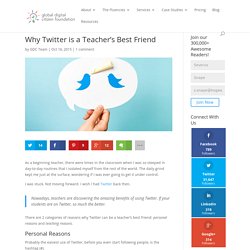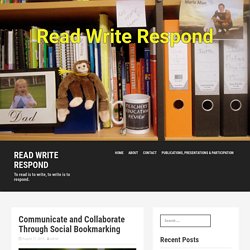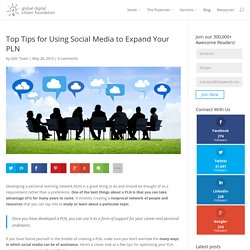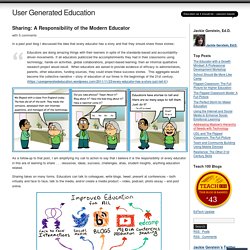

5 Do's and Don'ts for Expanding Your PLN as a Teacher. A professional learning network involves making connections and building personal relationships with other educators around the world for the purposes of sharing ideas, resources, and voicing educational concerns.

Becoming Connected Is Easier Now More Than Ever. This post is sponsored by Samsung.

All thoughts and opinions are my own. Across the globe educators just wrapped up celebrating Connected Educators Month. Why Twitter is a Teacher's Best Friend. As a beginning teacher, there were times in the classroom when I was so steeped in day-to-day routines that I isolated myself from the rest of the world.

The daily grind kept me just at the surface, wondering if I was ever going to get it under control. I was stuck. Not moving forward. I wish I had Twitter back then. Nowadays, teachers are discovering the amazing benefits of using Twitter. There are 2 categories of reasons why Twitter can be a teacher’s best friend: personal reasons and teaching reasons. Personal Reasons. PWP – Personal Web Presence. I have heard educators say they do not want to be on the Internet.

Get Connected - SLAV - Google Slides. Get connected with Google+ Attention, and Other 21st-Century Social Media Literacies. © 2010 Howard Rheingold.

The text of this article is licensed under the Creative Commons Attribution NonCommercial License ( EDUCAUSE Review, vol. 45, no. 5 (September/October 2010): 14–24 Howard Rheingold (howard@rheingold.com) is the author of Tools For Thought, The Virtual Community, Smart Mobs, and other books and is currently lecturer at the University of California, Berkeley, and Stanford University. ‘I Link, Therefore I Am’: Network Literacy as a Core Digital Literacy. Social Capital and PLNs: Discovering, Building, and Cultivating Networks of Learners. Curation as a tool for teaching and learning (with images) · hbailie. Learn, do, teach... I published my digital essay on Storify on Sunday afternoon and publicised the fact on Twitter and through the subject forums.

Communicate and Collaborate Through Social Bookmarking. Flickr photo shared by mrkrndvs under a Creative Commons ( BY-SA ) license One of the challenges when working managing the abundance of knowledge and ideas is how we make sense of it.

Although there is a tendency to rely on Google to recall websites, there is something lost when we hand over the curation process to someone else. Some take the first step of saving links to the favourites in the browser. This works, until our computer crashes and we loose all those links. Ten Step Program to Being Connected; or Getting Connected for Dummies. Heather Bailie on Pinterest. The Best Free Resources for Perfecting Your PLN. Professional Learning Networks (PLN) are the lifeblood, the sustainer, the nurturer of the modern digital teacher.

Should Every Teacher in the World Really be on Twitter? Top Tips for Using Social Media to Expand Your PLN. Developing a personal learning network (PLN) is a great thing to do and should be thought of as a requirement rather than a preference.

One of the best things about a PLN is that you can take advantage of it for many years to come. It involves creating a reciprocal network of people and resources that you can tap into to study or learn about a particular topic. Sharing: A Responsibility of the Modern Educator. In a past post blog I discussed the idea that every educator has a story and that they should share those stories: Educators are doing amazing things with their learners in spite of the standards-based and accountability-driven movements.

If all educators publicized the accomplishments they had in their classrooms using technology, hands-on activities, global collaborations, project-based learning; then an informal qualitative research project would result. When educators are asked to provide evidence of efficacy to administrators, parents, other educators, funding sources, they could share these success stories. This aggregate would become the collective narrative – story of education of our times in the beginnings of the 21st century. Personal Learning Networks for Educators: 10 Tips - Getting Smart by Guest Author - edchat, EdTech, PLN. By Dr. Mark Wagner I often begin my workshop on personal learning networks (PLN) for educators by asking these questions: Who is in your learning network? Learning professionally with Google+ Communities. Google educator Kimberley Hall recently presented a full day workshop for School Library Assoc of Victoria.
For some delegates it was a glimpse into the possibilities of the Google Apps for Education (GAFE) tool-base, for others it was an opportunity to enhance their existing knowledge with the leadership of a dynamic trainer. Educational institutions, from primary to secondary schools, through to universities, are now using GAFE, so skill in managing the range of tools such as Google Docs, Tables, Presentations and the indispensable Google Forms with confidence is essential. How to Connect With Other Teachers in the Social Age. In the 2012 Primary Sources Survey conducted by Scholastic and The Gates Foundation, teacher respondents claimed to spend only about 4% of each day collaborating with colleagues, while 44% of teachers surveyed responded that they would like that collaboration time to increase.
Traditionally, the teaching profession has been an isolating one—if you’re not spending every minute at school teaching classes, tutoring during your breaks, or covering someone else’s class, then you’re likely spending that time disciplining, administrating testing, or scrambling to the microwave to reheat leftovers during your 15-minute lunch break. How is “Connected” Connected? As with many words, the word “connected “ can be used for many things. At one point in time “being connected” implied a criminal connection to some sort of organized crime. Being connected has also meant having ties to the higher ups in an organization for the purpose of favors and perks. The word connection, simply stated, means to be united, or linked. Thing One: Twitter – Learn, do, teach...too. A Good Twitter Visual Guide in Dr. Seuss Style. November 1, 2014 How about a Twitter guide in Dr. How Students Benefit From Social Media.
Being a Connected Educator: Face to Face. Being a connected educator means connecting with other teachers to exchange ideas, improve your teaching practice, and in turn, make a change in education. Three Easy Tips for Teachers on Twitter — Bright. Teaching the Teachers, 140 Characters at a Time — Bright. Educators around the world are gathering on Twitter for professional development. What has the network done for your education career?
Why educators can't live without social media. Connected Leaders: Engaging School Communities Through Social Media. Social Media Explained (As A City) How Google+ is Rethinking Social Media. You may remember a few years ago when Google+ attempted to compete with Facebook as a social website. Terrific Tales of Teachers and Twitter in the Classroom. Let’s have an honest discussion about Twitter and teachers. What makes Twitter a tool that teachers would want to use? How have teachers already used Twitter? 10 Social Media Skills for 21st Century Teachers. The Beginner's Guide to Google+